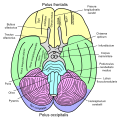Parahippocampal gyrus
Parahippocampal gyrus or hippocampal gyrus refers to a region of the brain whose gray matter is assigned to the cerebral cortex and is part of the limbic system . This area plays an important role in recognizing and remembering ; its involvement in the context of hippocampal sclerosis (a common structural finding in temporal lobe epilepsies ) could be demonstrated.
Assignment
The parahippocampal gyrus is located medially in the temporal lobe . Its posterior area, together with the fusiform gyrus, forms the parahippocampal cortex . Part of the posterior area of the parahippocampal gyrus is also known as the Parahippocampal Place Area (PPA) .
function
Optical recognition
For example, an area of the parahippocampal gyrus , the so-called Parahippocampal Place Area, appears to be involved in the recognition of buildings. In fMRI studies, this region of the brain became particularly active when the test subjects were shown topographical views or images of landscapes, cities or spaces. This region was first described by Russell Epstein (currently at the University of Pennsylvania ) and Nancy Kanwisher in 1998.
Damage to the Parahippocampal Place Area (for example as part of a stroke ) can mean that those affected cannot assign landscapes or other locations, even though they recognize individual sub-areas (for example objects or people).
Associative function
It is believed that the function of the parahippocampal gyrus goes beyond purely visual recognition. There is evidence that this area of the brain is involved in the recognition of both social contexts and language.
Further representations
See also
- Uncus , part of the parahippocampal gyrus
Individual evidence
- ↑ Federative Committee on Anatomical Terminology (Ed.): Terminologia Anatomica . Thieme, Stuttgart 1998.
- ^ W. His: The anatomical nomenclature. Nomina Anatomica. The anatomical society on its IX. At the meeting in Basel . Veit & Comp., Leipzig 1895.
- ↑ NF Ferreira, V. de Oliveira, L. Amaral, R. Mendonça, SS Lima: Analysis of parahippocampal gyrus in 115 patients with hippocampal sclerosis . In: Arq Neuropsiquiatr . 61, No. 3B, September 2003, pp. 707-711. PMID 14595469 .
- ↑ McDonald B, Highley JR, Walker MA, et al. : Anomalous asymmetry of fusiform and parahippocampal gyrus gray matter in schizophrenia: A postmortem study . In: Am J Psychiatry . 157, No. 1, January 2000, pp. 40-47. PMID 10618011 .
- ↑ a b Research report University of Leipzig 2003: Experimental Neuropsychology - Determinants of Interhemispheric Resource Sharing , here online ( Memento of the original from September 10, 2007 in the Internet Archive ) Info: The archive link was inserted automatically and has not yet been checked. Please check the original and archive link according to the instructions and then remove this notice. ; last accessed on March 27, 2010
- ↑ Russell Epstein, Nancy Kanwisher: A cortical representation of the local visual environment . In: Nature . 392, April 9, 1998, pp. 598-601. Retrieved November 3, 2009.
- ^ Aguirre et al .: The Parahippocampus Subserves Topographical Learning in Man . In: Cerebral Cortex . 6, No. 6, August, p. 823. Retrieved November 3, 2009.
- ^ Distributed representation of objects in the human ventral visual pathway - PNAS . Retrieved November 3, 2009.
- Jump up ↑ Katherine P. Rankin, a Neuropsychologist, Studies Sarcasm - NYTimes.com . Retrieved November 3, 2009.




